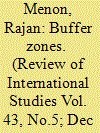| Srl | Item |
| 1 |
ID:
157612


|
|
|
|
|
| Summary/Abstract |
Amidst calls for containing an assertive Russia, politicians and pundits have been debating whether Ukraine should serve as a ‘buffer zone’ between the Russian and Western spheres of influence. These debates provide an opportunity to revisit the long and varied history of major powers’ efforts to manage buffer zones. We draw on this history to learn the conditions under which buffer zones succeed or fail to stabilise regions, how buffers are most successfully managed, and when alternative arrangements for borderlands work better.
|
|
|
|
|
|
|
|
|
|
|
|
|
|
|
|
| 2 |
ID:
191725


|
|
|
|
|
| Summary/Abstract |
The recent Russian invasion of Ukraine has led many commentators to remark that ‘geopolitics is back’. And with geopolitics, the interest in buffer zones is back as well. Yet, International Relations scholarship on buffer zones is confusing and outdated. Scholars disagree on the definition of buffer zones and whether such zones are a vestige of the great power politics of the past or a continuous phenomenon. In this article, we take three steps to reconceptualize buffer zones and their role in international relations. First, we clarify the conceptual confusion by advancing a new definition differentiating between nominal and active buffer zones. Second, we make the case that buffer states and internal buffer zones (i.e., geographic borderlands located within states in rivalry, adjacent to the international borders between the two rivals) share much in common and therefore should be analysed in tandem. Third, we offer a typology of buffer zones with short case-studies based on the dyadic relations of rival states vis-à-vis buffer zones between them. Our goal is to provide a new analytical framework that can serve as a base for a robust research agenda on the role of buffer zones in regional and international stability and security.
|
|
|
|
|
|
|
|
|
|
|
|
|
|
|
|
| 3 |
ID:
164255


|
|
|
|
|
| Summary/Abstract |
The article expounds the conceptual content of “civilizational realism” as part of the international relations theory that could help bridge the painful gap between science and practice increasingly manifest in the West, yet even more so in Russia. The ideas of “civilizational realism” are compared with similar views of leading U.S. political experts who brood over the present world order and Russia’s place in it. Some suggest resolving existing contradictions between Russia and the West by reaching an agreement with the “civilizational leaders” of the Euro-Atlantic region to create a demilitarized buffer zone made up of limitrophe Eastern European states
|
|
|
|
|
|
|
|
|
|
|
|
|
|
|
|
| 4 |
ID:
145951


|
|
|
|
|
| Summary/Abstract |
Buffer zones as a concept have a long history. Despite their frequent occurrence in international relations past and present, however, they have been treated in passing by scholars and policymakers alike, and then usually from a purely historical perspective. Their importance in conflict management, third-party intervention and power politics are not adequately mirrored in scholarly research. This article seeks to remedy this lapse by re-introducing the buffer zone as a tool of international conflict management in a new and systematic fashion. In this article, we survey buffer zones, their conceptual roots and characteristics, and illustrate our theoretical findings with an array of different examples—predominantly from the twentieth and twenty-first centuries. In so doing, we make three fundamental arguments about buffer zones.
|
|
|
|
|
|
|
|
|
|
|
|
|
|
|
|